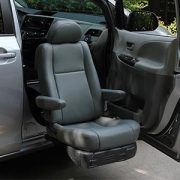Is there a difference between adaptive & accessible vehicles?
Adaptive Vehicles
Also known as adapted vehicles, these are vehicles that modified to allow for operation of a vehicle by a person with limited mobility. The industry’s terminology can be confusing. Adaptive vehicles may also refer to a converted vehicle or one that has been re-manufactured for highway safety and full independent access for entering/exiting the vehicle in the wheelchair independently.
Kansas Truck Mobility has three major adaptive services that it offers: Adaptive Seating, Wheelchair Lifts, and Hand Controls and Driving Aids.
Adaptive Seating, includes the Bruno Valet Plus and the Bruno Stow-Away seating, and seating options by Adapt Solutions. These seating options make use of a special seat that is either inside the cab or stows away under the vehicle. The wheelchair user must be able to transfer to the adaptive seat which is installed inside the vehicle.
Wheelchair lifts can be installed on the interior or exterior of the vehicle. There are as many as 25 different wheelchair lifts, and the year, make and model of the vehicle, and the weight and size of the power wheelchair, manual wheelchair or scooter dictate which wheelchair lift is right for both the person and the vehicle.
We also offer Hand Controls & Driving Aids. These include:
- Hand Controls
- Steering Controls
- Extension Controls (brake pedal extensions, key extensions)
- Accelerator Controls (brake guards to be used in conjunction with hand controls)
Accessible Vehicles
Accessible vehicles are a broader term for any vehicle that can be accessed via wheelchair, most commonly via a side-entry or rear-entry ramp. These require vehicles with ample interior space that can be converted to allow for a passenger to remain seated in their mobility equipment in the vehicle.
The difference between adaptive vehicles and accessible vehicles largely depends on the needs. Adaptive vehicles often require the wheelchair user to transfer from their mobility equipment.
We previously wrote about side entry vs. rear entry accessible vehicles, and if the person using a wheelchair wants to drive or be a passenger in the front seat. If they want to drive or ride shotgun, then side entry is the option to choose. Side entry vehicles typically have removable front seats, according to BraunAbility. This allows a person in a wheelchair to choose between driving or riding in the front passenger position.
Whatever your needs might be, you should always rely on a mobility dealer for these services. Kansas Truck Mobility is a QAP certified mobility equipment dealer and has met the standards set by the National Mobility Equipment Dealers Association for excellence in sales, service and installation.
Contact Chris Walden at (800) 365-0217 orr(316) 722-4291 for more information. Or you can email at cwalden@kansastruck.net.







